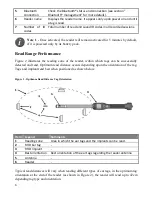
18
Note 22 –
Once the USB cable is connected, the reader is automatically powered
on and it will remain activated until the cable is disconnected. The reader will be
able to read a tag if a sufficiently charged battery is inserted. With a depleted
battery, the reader will not be able to read a tag, but will remain on and can only
communicate with computer.
When connecting to a PDA or a PC, you may need to install specific drivers supplied by
manufacturer. When connecting to a Windows PC, the operating systems start the Device
Manager (more details provided by the manufacturer on the CDROM).
Using serial interface
The serial port allows the device to send and receive data via an RS-232 connection.
To establish a USB connection, simply connect the reader with a PC or a PDA with the data-
power cable.
The RS232 serial interface comprises a 3-wire arrangement with a DB9F connector, and
consists of transmit (TxD/pin 2), receive (RxD/pin 3), and ground (GND/pin 5). This
interface is factory configured with the default settings of 9600 bits/second, no parity, 8
bits/1 word, and 1 stop bit (“9600N81”). These parameters can be changed from PC
software.
Serial output data appears on the device’s TxD/pin 2 connection in ASCII format.
Note 23 -
The RS232 interface is wired as a DCE (data communications
equipment) type that connects directly to the serial port of a PC or any other device
that is designated as a DTE (data terminal equipment) type. When the device is
connected to other equipment that is wired as DCE (such as a PDA), a “
null
modem
” adapter is required in order to properly cross-wire transmit and receive
signals so that communications can occur.
Note 24
- The reader’s serial data connection can be extended using a standard
DB9M to DB9F extension cable. Extensions longer than 20 meters (~65 feet) are
not recommended for data. Extensions longer that 2 meters (~6 feet) are not
recommended for data and power.
Using Bluetooth® interface
Bluetooth® works on a premise that one end of the communication will be a MASTER and
the other a SLAVE. The MASTER initiates communications and looks for a SLAVE device
to connect to. When the reader is in SLAVE mode it can be seen by other devices such as a
PC or PDA. PDAs and computers usually behave as MASTERS with the reader configured
as a SLAVE device.















































